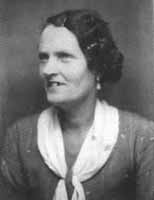© Valda Low
INTRODUCTION
Sally Sloane has an important place in the history of traditional music in Australia.

She was the most documented traditional performer in Australia and the source of many collected tunes and songs. Some time back I was shown a folder containing the seeds for a book about Sally’s collected songs. It began with a forward written by John Meredith, one of Australia’s foremost collectors of traditional music.
I realised when reading his words that although much has been written about the songs and tunes that he and others collected from her, I could find very little about Sally herself. With his blessing I set out to correct this.
Here is what I discovered about Sally Sloane.
SARAH ALEXANDER – Sally’s grandmother
Sally’s maternal grandmother Sarah Alexander was born to James Alexander and Mary (Lloyd) in Belfast, Ulster, Ireland c. 1816. In 1838, at the age of 22, she left Ireland with her brother and sailed to Australia. Sally said that during the voyage Sarah sang “Adieu My Lovely Nancy” at a concert. The song became a favourite of the captain.
Although her grandmother had died six years before she was born, Sally acknowledged that Sarah was a trained singer who knew many songs and dance tunes. Many of these songs and tunes were later passed down to Sally from her own mother.
In 1843 Sarah Alexander married Richard Burrowes (Burrows) in Sydney and they had 4 children – a daughter: Jane (1844) and 3 sons: James (1845), Richard (1847), and Charles(1851).
After her husband Richard’s death, probably in 1851, Sarah married George Dean (Deans) . This marriage took place on April 5 1852 at Shepherd’s Creek, Wellington, New South Wales and it was a Church of England service. The witnesses were a Charles and Norah White. George was born in Cambridge England and was about 35 years old, as was Sarah. They went on to have four children, all born in New South Wales – two sons: James (1851) and George (1853) – and two daughters: Elizabeth (1856) near Wellington and Sarah Ann (1859) at Narrowgall, near Wellington.
On July 21, 1863, Sarah’s husband George died at Newrea NSW. He was buried in nearby Wellington. She was left with the 4 children under 12 but she also had had 4 more by her first husband.
On September 26 the following year Sarah married again, this time to James Kenny (Kenney) in Wellington, NSW. The witnesses at this marriage were Thomas Coonan and Jane Doran, who was Sarah’s daughter to Richard Burrows. This time it was a civil ceremony. In 1872 James Kenny was farming at Back Creek near Black Rock.
Sarah Kenny (nee Alexander) died 17 March 1889 at Babinda Station, Nymagee, New South Wales and was buried at Nymagee two days later.
SARAH ANN DEAN AND TOM FROST – Sally’s parents
Sarah Alexander’s last born child, Sarah Ann Dean, was delivered by Mrs Clayton on June 1, 1859 at Narragall (Narrowgall), near Wellington .

When she grew up she learned to play concertina, button accordion, jews harp and piano. She also was a good singer and learned many of her mother’s old Irish songs.
On December 20 1880, Sarah married Thomas Frost (known as Tom) at the Church Of England Church at Eugowra in New South Wales. At the wedding, their friend, Bruce Crocket of Dripstone, played his concertina .
Tom Frost was born in Penrith New South Wales in December 1860. He was from early convict stock, his maternal great-grandparents, Anthony Rope and Sarah Pulley (Powley) having sailed on the First Fleet. Tom’s paternal grandfather had also been transported to Australia on a convict ship. Like his father, Tom Frost drove coaches for Cobb and Co.
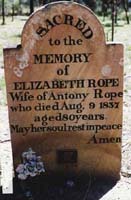
Over the next fourteen years Tom and Sarah Frost moved around western New South Wales and had ten children, including two sets of twins.
- Albert Charles – 1881
- Thomas A. – 1883
- William C. – 1884
- Ivy May – 1886
- James Christopher – 1888
- Vere Maud – 1890
- Elizabeth – 1892
- William – 1892
- Bertha Josephine Isabell – 1894
- Eunice Eveline Mary (Sally) – 1894
They were in Orange in 1882 but by 1888 they had settled in Parkes.
EUNICE EVELYN FROST – Sally Sloane
The last child to Sarah and Tom Frost was born on October 3 1894 at Parkes, the younger of twin girls. She was christened Eunice Evelyn Frost but was known later in life as Sally Sloane. Sarah knew the bushranger Ben Hall‘s sister-in-law and she was the midwife who attended when the twins were born. At the time Tom was still a mail driver.

John Meredith wrote that Sally’s mother Sarah divorced Tom Frost and married William Clegg. I have not as yet found evidence of this. She did however live with Clegg who was originally a gold miner. He later worked in many parts of New South Wales as a railway construction worker, mainly as a ganger on railway building jobs.
Sarah and the younger children travelled with him, camping on the job throughout New South Wales and into Queensland. Bertha and Sally may have been the only children to travel with their mother and William Clegg around the railway camps. It is interesting to note that although they were the children of Tom Frost, both Sally and Bertha married using the maiden name Clegg.
Through his many interviews with Sally, John Meredith learnt that she had the the ability to learn songs and tunes easily. A number of her songs came from goldminer Billy Page in Parkes, a friend of her father. She told John Meredith that other sources of songs and tunes were Bob Vaughan of Aberdeen, Peter Owen of Parkes, Jack Archer, an itinerant railway worker, Harry Bartlett of Parkes, Annie Shaw of Parkes, Jo Bow of Tambar Springs and also from William Clegg. But the bulk of Sally’s songs and tunes were learned from her mother such as a lament for Ben Hall.
The same song was sung by Bruce Crocket the man who played at her mother’s wedding so it is possible that Sarah Frost got the ballad from him or from the same source. As a young girl she had already mastered her mother’s instruments as well as the fiddle, mouth organ and tin-whistle. From an early age, she was playing for small bush dances, and entertaining others with her songs.
SALLY MARRIES JOHN MOUNTFORD
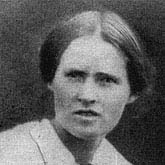
In June 1911, at the age of 17, Sally (Eunice) married John Phillip Mountford. He also used the name “Ford”. He was 28 years old and a miner living at Ashley, just out of Moree. Interestingly, her twin sister Bertha married a week before to William H. Gibbons. Both marriages took place at All Saints, Moree, New South Wales. Both girls added a Christian name to their own which does not appear on their birth certificates. They also used Clegg as their maiden names.
Sally is named as Eunice Evelyn ‘Mary’ Clegg and her sister is Bertha ‘Josephine’ Isabel Clegg. They were just 17years old, born in Parkes and now living in Moree. It is interesting that they state on the certificates that their father is William Andrew Clegg when, in fact, their natural and legal father was Thomas Frost. Interesting too is the fact that William Clegg gave his consent “in writing” to their marriages.
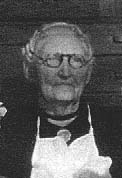
Not much has come to light so far about Sally’s marriage to John Mountford. He was born at Bumburnie in 1883 and baptised John Philip Malycha at Sevenhills, both in the district of Clare, South Australia. His parents were Andrew Malycha and Mary Jane Doubtfire (known as Jane) and they had married in 1874 at Clare. John Philip was the last of their five children.
Sometime after his birth, his mother Jane Doubtfire/Malycha left with Alexander Mountford and presumably her children. John was only six years old in 1889 when Jane and Alexander were living at or near Broken Hill. They later moved to Orange where Alexander Mountford died in February 1898. They never married but had six further children. When Jane died in the State Hospital in Newington in 1933, her death certificate was registered under the surname Malycke [sic]. She was buried in the Roman Catholic cemetery at Rookwood in Sydney. Interestingly, in 1905, back in South Australia, Andrew Malcke described himself somewhat inaccurately as a widower. He died nine years later.
John Philip Mountford and Eunice Clegg (Sally Malycha/Frost) did not stay in Dubbo long after they were married. They moved regularly around New South Wales and had five children in the first six years of their marriage:
- 1912 – Sarah Ann born in Sydney
- 1913 – Mary Ellen born and died in Gulgong
- 1914 – Doris May born in Mudgee
- 1916 – Bertha Elizabeth born and died in Coonabarabran
- 1917 – John Clegg Alexander born in Coonabarabran.
Little is known about what Sally was doing between the wars. For much of her adult life Sally lived in country towns west of the Blue Mountains. Sometime in the 1940s Sally took in her niece, a child called Jean. It is believed that Sally had taken her in because Jean’s own family was too large.

THE POST WAR YEARS
On December 19, 1947 Sally’s mother Sarah died at Kamandra in Parkes, New South Wales, where she is buried in the Roman Catholic cemetery.
By 1947 Sally was living with Frederick Cecil Sloane, at 18 Lemnos Street, in the coal-mining and manufacturing town of Lithgow, on the western side of the the Blue Mountains. Fred was a grinder by trade. Sally and Fred were still living there in 1955.
It was at this address that John Meredith first recorded Sally Sloane as she called herself by then. Sally and Fred Sloane never married. To most who knew them, Fred Sloane was Sally’s second husband. They were partners for over 35 years. Sally had even told John Meredith that a condition of her marriage to Fred was that she never again mentioned the name of her first partner.
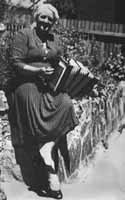
“I was never able to get any information regarding him, or even his name,” John Meredith said. “When I raised the topic, Sal would lay her forefinger to her lips and silently shake her head.”
John Meredith met the Sloanes in 1954 during a performance given by The Bushwhackers at Lithgow. The Bushwhackers was the name of the performing musical group who formed the Sydney Bush Music Club.
He recalled that after they had made an appeal for traditional songs or music, Fred Sloane came to him and said, “If you want old songs you ought to see my missus -she’ll sing them all night once she gets going.” John Meredith was invited to stay over the next weekend, with his tape recorder. The first song he ever recorded of Sally Sloane singing was her version of “Ben Hall”.
During the following seven years John Meredith continued to visit the Sloanes regularly for weekend recording sessions, first at their cottage in Lithgow, then at Teralba, on Lake Macquãrie and finally back at Lithgow again. In all, he made about sixty visits to Sally and collected over 150 songs and dance tunes and the stories behind them.

photo by John Meredith
“She played button accordion, fiddle and mouth organ with equal facility, but was more at home on the accordion,” Meredith recalled. “It was one of those old ‘Mezon Grand Organ’ models, in the key of ‘A’ and with bronze reeds.”
On most visits she remembered another new tune, or maybe two, or half-a-dozen. He continued to visit Sally regularly until shortly before her death.
Folklorist Graham Seal has noted that Sally Sloane’s repertoire seemed to have three distinct musical styles : –
- “Anglo-Celtic material (mostly Broadside – derived) like ‘The Red Barn’ and ‘The Banks of Claudy’; Australian material such as ‘The Death of Ben Hall’,
- and a third strand of nineteenth and early twentieth century popular music.”
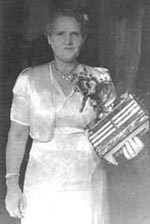 Her traditional music may have been of most interest to the collectors but her popular music was in just as much demand on the stage. She played at many events, both amateur and professional.
Her traditional music may have been of most interest to the collectors but her popular music was in just as much demand on the stage. She played at many events, both amateur and professional.
During World War Two she played at the Sydney Tivoli and was recorded there by ABC radio. John Meredith said:
“Amazingly Sally Sloane had two singing voices, which might conveniently be termed ‘folk’ and ‘stage’. The first was used for all those lovely old Irish ballads Sal had inherited from her grandmother, through the medium of her mother, and this was a hard, clear unemotional voice and style, very much in the Irish tradition. The other voice was reserved for those stage and art songs of probable music-hall origins. It was a rich mezzo-soprano with a little vibrato and she used it for such songs as ‘The Deep Shades of Blue’”.
For a ten year period, between 1956 and 1966, Sally and Fred Sloane moved to the central coast of NSW – firstly to Fennells Bay right on the water and then to Teralba, a little south of the industrial city of Newcastle. Fred was working as a fitter’s mate on the building of a power station at nearby Wangi. Building of the Wangi Power Station was commenced in 1955 (it was decommissioned in 1986).
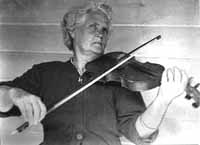
[photo by John Meredith]
Sally’s time on the coast was a busy one. The home at Teralba was a large rambling old Queenslander beside the railway line, not far from the lake. Her daughter Doris and her children would stay with her for a holiday every year or so. Sally liked to potter in the garden and played bowls in Newcastle. She would visit Sydney fairly often, to sing and play at the concerts of the Bush Music Club of which she was made a Life Member.
In 1966 the first stage of the Wangi power station was completed. Sally and Fred returned to Lithgow, settling into a home at 32 Shaft Street.
CONCLUSION
Sally enjoyed singing all her life. At the age of 81 she sang at the 1975 Bush Music Festival.
Since John Meredith’s pioneering work, many collectors had visited Sally. In 1976 Warren Fahey and Graham Seal visited her in Lithgow. They spent a day interviewing Sally and listening to her sing and play. Warren had visited Sally on two earlier occasions and wanted to gather material for an LP recording of Sally.
By 1977 Sally and Fred had moved to 49 Coalbrook Street. Two years later they attended the Bush Music Club’s Second Colonial Subscription Ball at which Sally was the guest of honour.
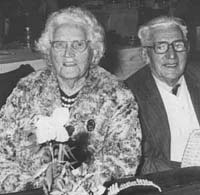
In 1980, whilst on a holiday to Albury, possibly to visit Jean, Fred Sloane died. He was buried i Wodonga Cemetery near the New South Wales -Victorian border. Sally was devastated as she had lost her daughter Doris the year before. She moved from Lithgow and lived in a caravan in Jean’s back yard. Tragically, in 1982, there was a fire and Sally was badly burnt. She was taken to Wodonga Hospital where she died three days later on September 20, 1982.
She was 88 years old.
COLLECTED SONGS AND TUNES
Collected from Sally Sloane by John Meredith
A
Annie Shaw’s Tune
B
Black Velvet Band
Break UpStep Dance
Banks of Claudy
Bonnie Maggie
Breakdown Boys of the Dardenelles
Ballad of the Drover
Banks of Sweet Dundee
Bright Shades of Blue Blackberry Blossoms
Bold MacGuinness
Bung Yer Eye
Ben Hall
C
Cry Lookout
Click Go the Shears
Caroline from Edinburgh
Cruiskeen Lawn
Christ was Born in Bethlehem
Coming Down the Mountain
Charming Judy Callaghan
D
Death of Ben Hall
Devil Among the Tailors
E
Erin’s Green Shore
Erin’s Green Isle
F
Finnegan’s Wake  Flowers of Edinburgh
G
Garryowen Golden Hair was Hanging Down her Back
Gargal Machree: Gragealmochroi
Grandma’s March
Girls of the Shamrock Shore
H
Haste to the Wedding Hiawatha Hornpipe Tune Hornpipe
I
I Think By This Time
I Think by this Time he’s forgot her
I am leaving Dublin Town
I’ve got a Wife
I Long for to get Married
Ireland Free Once More
Impudent Barney O’Hay
I’ve Been a Wild Boy
I’ve been a Wild Boy
If I was a Blackbird
Irish Washerwoman
J
Jacks Waltz
John Doolan Wild Colonial Boy
Jig Tune x3
Jingle Bells
K
Kitty Jones
Killalloo
Knickerbocker Line
(station cook tune + Great Northern Line tune + Lachlan Tigers)
L
Learning MacPherson to Waltz
Larry Doolan: 16,000 miles from Home
Lovely Molly
Lovely Nancy
Lowlands of Holland
Lovely Willie
Look Out Below
M
My Bonnie Love is Young
Miss McLeod’s Reel
Molly Ban Lavery
My Pretty Maid: Seventeen Come Sunday
My Son Ted
Maid of Fainie
McDonald of Glencoe
Martin O’Flynn
Mountain Belle Schottische
Mum’s Mazurka
Maggy Murphy’s Home
May Your Children strike You
N
Never Laugh at a Man When He’s Down Nicky Nick Nack
O
Oh Get Away you Savey Dame: A Cherry Tree
Oh, Bedad then Says I
P
Polka Tune No 3: Bob’s
Polka Tune No 1
Polka Tune No 2: I’ve got a Bonnet
Paddy’s Land: The Rose Tree
Paddy Casey
Paddy Fagan
Phil the Fluter
Paddy my Dear, don’t Bother Me
Polka Tune
Q
Quakers Wife
R
Rakes of Mallow
R em. of Ben Hall
Rocky Road to Dublin
Rosin the Bow
Rocking a Wee One
S
Set Dance – Bert Meredith’s
St. Patrick’s Day in the Morning
Starry Night for a Ramble
Soldier’s Joy
Sadly the Cuckoo is Calling
Set Tune
Sweet Lukin Town
She’s the Tart for a Bushman
Springtime Brings on the Shearing
She’s Dressed in a Man’s Array
Stockyards Tune
Squire Scoble
Seamus O’Brien
Sally’s Reel
Sally’s Reel No 2: Dan Tucker
T
The Rambling Sailor
The Red Rose Top: Sprig of Thyme
The Wind that Shakes the Barley
The Coolgardie Miner First Set Tune
The Convict’s Return
Three Legged Stool
The Cockie’s Daughter
The Old Clay Pipe Tatter Jack Welsh
The Knickerbocker Line
The Girl with the Flowing Hair
The Maid of Sweet Gauteen
The Green Bushes
The Stockyards
The Dying Stockman
The Red Barn
The Blackberry Blossom
The Journeyman Tailor
The Green Bushes
The Gallant Band
The Cherry Tree
The Roving Beggarman
The Sporting Paddy
The Chandler’s Wife
The Wee One
The Shoenmaker’ Son
U
Unfortunate Rake
Up in a Balloon
Up with the Orange, the Purple and Blue
V
Varsovienna No.2
Varsovienna
W
Wallaby Track
Waltz Tune: Willy Digby
Wexford Murder Air
We’ll Boldly go to Sea
What would you do if the Billy boiled over
Whistle to My Blackbird
Wee One
Warrego Lament
XYZ
Young Pat McGuire
Young Jimmie was a Shoemaker’s Son
Collected from Fred Sloane by John Meredith
The Dog story…………………………………….told by Fred Sloane
Nails and Pocket story…………………………….told by Fred Sloane
Fox Whistle story…………………………………told by Fred Sloane
Jacky and the Brown Sheep story…………………….told by Fred Sloane
Jacky and the Whiskey story………………………..told by Fred Sloane
The Greasy Cook recited …………………………..by Fred Sloane
REFERENCES
- Wattle recording sleeve notes Edgar Walters
- FOLK SONGS OF AUSTRALIA And the men and women who sang them John Meredith and Hugh Anderson, VOL 1
- Registry of Births Deaths and Marriages
- electoral rolls
- DEATH OF SALLY SLOANE John Meredith Stringybark and Greenhide 1983
- Graham Seal: SALLY SLOANE 1894-1982
- Review: A Garland For Sally Larrikin, LRF136, 1983 Stringybark and Greenhide vol 5 no2 1984
- OBITUARY: Mulga Wire No 34: Dec 1982 THE SWEET SONG IS STILLED Real Folk, John Meredith
THANKS TO THE FOLLOWING FOR THEIR HELP:
Gregory Lauder-Frost; Cheryl Wotton; Wendy Walsh; Bob Bolton; David Mulhallen; Rob Willis; Jim Low

